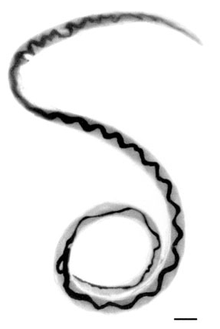| Angiostrongylus cantonensis | |
|---|---|

| |
| Adult female worm of Angiostrongylus cantonensis with characteristic barber-pole appearance (anterior end of worm is to the top). Scale bar is 1 mm. | |
| Scientific classification | |
| Domain: | Eukaryota |
| Kingdom: | Animalia |
| Phylum: | Nematoda |
| Class: | Chromadorea |
| Order: | Rhabditida |
| Family: | Angiostrongylidae |
| Genus: | Angiostrongylus |
| Species: | A. cantonensis
|
| Binomial name | |
| Angiostrongylus cantonensis (Chen, 1935)[1]
| |
| Synonyms[2] | |
|
Pulmonema cantonensis Chen, 1935 | |
Angiostrongylus cantonensis is a nematode (roundworm) parasite that causes angiostrongyliasis, an infection that is the most common cause of eosinophilic meningitis in Southeast Asia and the Pacific Basin.[3] The nematode commonly resides in the pulmonary arteries of rats, giving it the common name rat lungworm.[4] Snails and slugs are the primary intermediate hosts, where larvae develop until they are infectious.
Humans are incidental hosts of this roundworm, and may become infected through ingestion of larvae in raw or undercooked snails or other vectors, or from contaminated water and vegetables.[5] The larvae are then transported via the blood to the central nervous system, where they are the most common cause of eosinophilic meningitis, a serious condition that can lead to death or permanent brain and nerve damage.[6] Angiostrongyliasis is an infection of increasing public health importance, as globalization contributes to the geographic spread of the disease.[7][8]
- ^ Cite error: The named reference
Chen 1935was invoked but never defined (see the help page). - ^ "Angiostrongylus cantonensis (Chen, 1935)". Global Biodiversity Information Facility. Retrieved 21 August 2023.
- ^ Baheti NN, Sreedharan M, Krishnamoorthy T, Nair MD, Radhakrishnan K (March 2008). "Neurological picture. Eosinophilic meningitis and an ocular worm in a patient from Kerala, south India". Journal of Neurology, Neurosurgery, and Psychiatry. 79 (3): 271. doi:10.1136/jnnp.2007.122093. PMID 18281446. S2CID 207001013.
- ^ Sheikh K (July 12, 2019). "In Hawaii, Rat Lungworm Disease Infects People but Eludes Researchers". The New York Times. Retrieved 13 July 2019.
- ^ Magill AJ, Strickland GT, Maguire JH, Ryan ET, Solomon T (2012). Hunter's tropical medicine and emerging infectious disease (9th ed.). London: Elsevier Health Sciences. ISBN 9781455740437. OCLC 861539914.
- ^ Li H, Xu F, Gu JB, Chen XG (October 2008). "A severe eosinophilic meningoencephalitis caused by infection of Angiostrongylus cantonensis". The American Journal of Tropical Medicine and Hygiene. 79 (4): 568–70. doi:10.4269/ajtmh.2008.79.568. PMID 18840746. S2CID 2094357.
- ^ Eamsobhana P (December 2014). "Eosinophilic meningitis caused by Angiostrongylus cantonensis--a neglected disease with escalating importance" (PDF). Tropical Biomedicine. 31 (4): 569–78. PMID 25776582. Archived from the original (PDF) on 2017-08-29.
- ^ Dard C, Tessier E, Nguyen D, Epelboin L, Harrois D, Swale C, et al. (2020). "First cases of Angiostrongylus cantonensis infection reported in Martinique, 2002–2017". Parasite. 27: 31. doi:10.1051/parasite/2020032. PMC 7216674. PMID 32394891.
